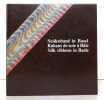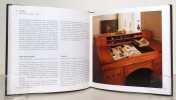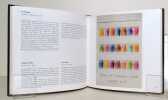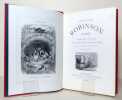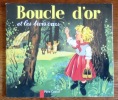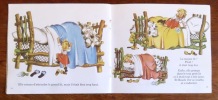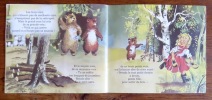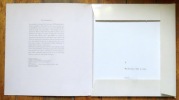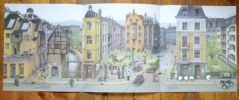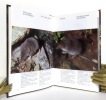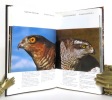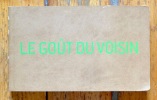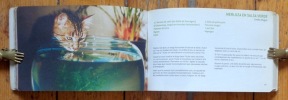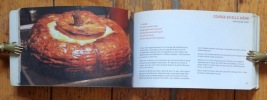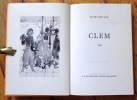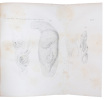3714 books for « muller h »Edit
-
Type
Autograph (1)
Book (3709)
Disk (1)
Drawings (2)
Engraving (2)
Magazine (7)
Music sheets (9)
-
Latest
Last 3 days (2)
Last month (28)
-
Language
English (4)
French (3711)
German (6)
Greek (1)
Russian (9)
-
Century
16th (7)
17th (2)
18th (38)
19th (329)
20th (1488)
21st (306)
-
Countries
Belgium (214)
Canada (7)
China (1)
Denmark (120)
France (2670)
Germany (1)
Greece (5)
Italy (8)
Switzerland (693)
United Kingdom (4)
United States of America (8)
-
Syndicate
ALAC (7)
CLAM (4)
CLAQ (2)
CNE (2)
ILAB (1717)
NVVA (229)
SLACES (229)
SLAM (1268)
SNCAO (5)
Topics
- Alps (14)
- Alsace (131)
- Ampelography - wines (24)
- Animals (11)
- Aquitaine (10)
- Archaeology (65)
- Architecture (41)
- Asia - orient (8)
- Astronomy (10)
- Basel (9)
- Belgium (13)
- Bibliography (9)
- Biography (36)
- Birds (10)
- Botany (26)
- Brittany (11)
- Children’s books (61)
- Christianity (17)
- Cooking (28)
- Dauphiné (24)
- Dedication (14)
- Detective novels (16)
- Dictionaries (11)
- Drawings (17)
- Early printed books (13)
- Economics (34)
- Education (22)
- Education - morals (13)
- Egypt (14)
- Engravings (9)
- Entomology (12)
- Ethic (12)
- Europe (10)
- Fashion (10)
- Fine arts (41)
- First edition (30)
- Fishing (10)
- Florence (23)
- Forez (9)
- Geography (36)
- Germanic languages (166)
- Germany (42)
- Greece (13)
- Helvética (190)
- History (202)
- Humour anecdotes (12)
- Ile de france (10)
- Illustrated books (9)
- India (9)
- Industrial arts & crafts - fine arts (20)
- La tour du pin (11)
- Law (31)
- Linguistics (21)
- Literature (236)
- Magazine (26)
- Medicine (63)
- Military arts (34)
- Muller charles (44)
- Muller eugène (73)
- Müller herta (13)
- Muller jean (30)
- Muller joseph-emile (35)
- Muller martine marie (24)
- Muller rené (19)
- Music (12)
- Navy (15)
- Newspapers press (32)
- Painters (21)
- Painting (19)
- Palaeontology (9)
- Philology (12)
- Philosophy (63)
- Photography (25)
- Poetry (10)
- Policy (18)
- Psychiatry neurology (17)
- Psychology (38)
- Reboux paul (26)
- Regionalism (27)
- Religions (51)
- Review (16)
- Reviews (28)
- Scandinavian literature (10)
- Sciences (30)
- Scores (31)
- Shapes & colours (9)
- Social sciences (8)
- Songs (11)
- Sports (10)
- Switzerland (190)
- Theatre (16)
- Theology (35)
- Travel (27)
- Various (28)
- Viticulture (18)
- War (42)
- Wine (29)
- Youth (14)
- Zoology (13)
- Zurich (17)
Porrentruy, une belle ville que l'on connait mal décrite et dessinée par C. A. Müller - Pruntrut, eine unbekannte, schöne Schweizer Stadt beschrieben un gezeinchnet von C. A. Müller.
Basel, Wepf Verlag, 1966. In-8 broché, couverture illustrée.
BIlingue français-allemand.
Gertrud Dübi-Müller. Vivre l'art, quand tout restait à faire.
Les Editions Noir Sur Blanc, 2017. In-4, cartonnage photographique. En belle condition.
Une immersion fascinante dans le royaume soigneusement gardé de Gertrud Dübi-Müller (1888-1980), photographe, collectionneuse, amie et mécène de pionniers de l'art moderne tels que Ferdinand Hodler, Cuno Amiet, Hans Berger ou Giovanni Giacometti. Orpheline à l'âge de six ans, elle est à peine majeure lorsqu'elle acquiert une toile de Vincent Van Gogh. Cet ouvrage, conçu par sa nièce Monique Barbier-Mueller et l'historien d'art Cäsar Menz, célèbre une personnalité unique, dont l'audacieuse collection incluait des oeuvres de Degas, Cézanne, Matisse, Braque et Picasso.
Siné, Allais Alphonse, Aymé Marcel, Boudard Alphonse, Favalelli Max, Lanzmann Jacques, Reboux Paul, Muller Charles:
Reference : 12533
11 livres de poche, couvertures de Siné.
Le livre de poche, 1965 à 1981. 11 volumes in-12 brochés, couvertures illustrées (pour la plupart recto-verso) par le géniailissime Siné. Quelques rares traces de plis, nom de possesseur sur la garde de certains volumes.
Alphonse Allais: Allais. . . grement - A la une, contes et nouvelles - Plaisir d'humour. Marcel Aymé: Travelingue - La belle image - Derrière chez Martin - La tête des autres. Alphonse Boudard: La métamorphose des cloportes. Max Favalelli: Mots croisés, troisième recueil. Jacques Lanzmann: Rue des mamours. Paul Reboux et Charles Muller: A la manière de. . .
Une nuit dans la forêt.
Genève, Notari, 2009. In-12, plein skyvertex titré or, vignette couleurs contrecollée au premier plat. Tout beau tout neuf.
"Une nuit dans la forêt, c’est bien une promenade exploratoire au-delà du miroir, rendue possible par le dialogue du poète avec une voix sortie d’entre les mains de l’artiste plasticien: ces figures (voir les photographies) – taillées, gravées, sculptées, têtes ou masques étranges et fascinants par leur hiératisme, la fixité de leurs regards – sorties tout droit des galeries secrètes d’un musée d’ethnographie imaginaire, dégagent en effet une aura de magie qui attire irrésistiblement le contemplateur et lui intime le silence, l’écoute, le questionnement." Premier tirage limité à 475 exemplaires, le nôtre un des 450 sur papier courant.
Vent fou.
Flammarion, les Albums du père castor, 1963. In-8 broché, couverture couleurs. En belle condition.
Collectif - Fernando Puig Rosado, Antonio Fernando Santos, Frits Müller, Jean Ballesta, Fred Klitz, Frank H. Wagner, Oscar Conti, Carsten Lorange, Antonio Mingote, Pimon Kalasih, Mogens Juhl:
Reference : 1719
Ataraxie et humour / Ataraxia y humor / Ataraxia and humour / Ataraxie und Humor / Ataraxie en humor.
Bruxelles, Division pharmaceutique, Union chimique belge. In-4 broché à l'italienne non paginé, couverture ornée d'un masque riant, première page de papier pergamine imprimé. Premier plat légèrement insolé en bord inférieur, quelques légères traces de plis.
Rare ouvrage collectif en 5 langues. Illustré à toutes pages en noir par des dessinateurs venant des pays suivants: Espagne, Portugal, Pays-Bas, Etats-Unis, Argentine, Suède, Danemark, Thaïlande.
Voyages from Asia to America, for completing the discoveries of the north west coast of America. To which is prefixed, a summary of the voyages made by the Rusians on the frozen sea, in search of a north east passage.
Amsterdam / New York, Nico Israel / Da Capo Press, Bibliotheca Australiana. 1967. In-4, plein skyvertex, pièce de titre au dos et au premiers plats. Le rhodoïd manque, pour le restet à l'état de neuf. Illutré de 4 cartes, dont 2 grandes dépliantes.
Fac-similé de l'édition de 1761. Volume 26 de la Bibliotheca Australiana.
Jim Morrison au-delà des Doors.
Albin Michel / Rock & Folk, 1974. In-12 broché, couverture couleurs (un brin défraîchie). Illustrations in-texte en noir.
Seidenband in Basel / Rubans de soie à Bâle / Silk ribbons in Basle.
Bâle, sans nom, 1983. In-12, cartonnage couleurs. Nom de possesseur, pour le reste en belle condition. Abondamment illustré en noir et en couleurs.
Cramatte Jean-Luc (photgraphies) - Etienne Barilier, Georges Haldas, Bernard Comment, Anne-Lise Grobéty, Hugo Loetscher, Charles-Henri Favrod, Jean-Bernard Vuillème, Grégoire Müller, Marielle Mehr, Alberto Nessi, Marie-Claude Dewarrat:
Reference : 18396
(1999)
Lieux ferroviaires.
Editions Grimoux, 1999. In-8 broché, couverture à rabats. A l'état de neuf.
Onze écrivains suisses (huit Romands, deux Alémaniques et un Tessinois) ont répondu à l'invitation du photographe Jean-Luc Cramatte d'évoquer le train, la gare, le passager Leurs textes sont illustrés de photographies en noir du photographe. Première édition, tirée à 1500 exemplaires.
Le nouveau Robinson suisse.
Ramsay / Jean-Jacques Pauvert, 1990. Fort volume in-4, cartonnage richement décoré en noir et or. Longue inscription au faux-titre, petites rousseurs sur tranches, pour le reste en belle condition. Illustrations in-texte en noir par Yan' Dargent.
Nouvelle édition conforme à l'originale.
Boucle d'or et les trois ours.
Flammarion, Le Père Castor - mini classiques, 1995. In-12 broché à l'italienne, couverture couleurs.
L'important, c'est la chose. . . en 12 leçons.
Vogue, sans date. Disque vinyle 33 tours / 30 cm., en parfait état (disque et pochette).
Ne nous mentons pas, si nous vous le proposons ici ce n'est guère pour les chansons grivoises (que nous n'avons d'ailleurs pas écoutées) mais bien pour la composition couleurs de Siné qui orne la pochette. . .
The Changing City.
New York, Margaret K. McElderry, 1977. Portfolio grand in-4, sous chemise couleurs à rabats. Bien complet des 8 planches dépliantes en couleurs montrant la même vue citadine et sa progession entre le 6 mai 1953 et le 7 janvier 1976. Discrets trous de punaise aux coins des planches.
"Il a fallu des millénaires et le génie de plusieurs civilisations pour apprivoiser la seconde, unité de mesure du temps. De l'ombre au quartz, une vaste fresque Baillod nous raconte cette extraordinaire épopée qui annonce l'avènement des techniques horlogères de pointe".
Animaux protégés de Suisse.
Ligue suisse pour la protection de la nature (LSPN), 1980. Petit in-8, cartonnage photographique. En belle contiion. Abaondamment illustré.
Index des espèces en fin de volume.
Le goût du voisin. 85 explorations.
MétisPresses, 2007. In-8 à l'italienne, cartonnage avec titre en vert. Premier plat légèrement voilé, frottements en bords - intérieur frais.
"Le goût du voisin a une vertu précieuse: celle de nous permettre de préciser ce qu’il faut entendre par « esthétique relationnelle ». Ces recettes glanées chez les voisins, avant d’être dessert, entrée ou plat principal, nous ouvrent les portes de l’intimité quotidienne de leurs auteurs. Chacune d’elle, inventive ou rituelle, exprime des désirs et des styles de vie, révèle des affinités ou des attachements culturels. Le goût du voisin fait de la variété des ingrédients et des saveurs réunies dans ces pages un témoignage d’une certaine manière de vivre ensemble. il concrétise une démarche artistique qui convie la double intimité de soi et de l’autre autour d’une même table. »
Clem. Roman.
Lausanne, La Guilde du livre, 1961. In-8, pleine toile orange décorée. En belle condition. Illustrations à pleine page en noir de Jacques Degenne.
Tirage limité à 8030 exemplaires numérotés, celui-ci numéro 1115. Ce livre obtint le Prix Interallié 1960.
Über den glatten Hai des Aristoteles, und über die Verschiedenheiten unter den Haifischen un Rochen in der Entwickelung des Eies. [In: Abhandlungen der Königlichen Akademie der Wissenschaften zu Berlin. Aus dem Jahr 1840]. - [ESTABLISHING ARISTOTLE AS THE FOUNDER OF BIOLOGICAL SCIENCE]
Berlin, 1842. 4to. Entire volume of ""Abhandlungen""... and ""Mathamatische Abhandlungen""... 1840 present. Contemporary yellow boards with a vellum-like spine. Handwritten title to spine. A bit of wear and soiling to extremities, and corners bent. Internally fine and clean. Stamp to title-page (Dom-Gymnasium Magdeburg, also stamped out). Pp. (187)- 257 + 6 plates, two of which are folded. Text very nice, bright, and clean, plates with a bit of brownspotting. [Entire volume: (6), XVII, (5), 400 pp. + 10 plates, 4 of which are coloured + (4), 137 pp.].
First printing of this foundational work, which established the acceptance, by the modern world, of Aristotle as the founder of biological science. It is due to the present work that modern encyclopaedias will now conclude that ""Aristotle is properly recognized as the originator of the scientific study of life."" (SEP). Apart from its importance to the modern view of Aristotle, the present paper was also central to Müller's construction of a natural system of the fishes. For centuries, the authority of Aristotle in matters of science and biology was unrivalled, but with modern science, the advancement of exact knowledge, and modern man's ability to investigate the smallest of details, Aristotle's scientific and zoological works increasingly came to be viewed as not properly belonging to the exact sciences. Many biologists would claim that his observations were fanciful and incorrect, not constituting any real scientific value. This view completely changed with the publication of the present paper, by the renowned zoologist Müller.In his ""Historia Animalium"", Aristotle had described a phenomenon in a shark, which no modern zoologist believed to be true. Had it been true, our classification among sharks and fish would need to be different, as this fanciful observation would completely alter our view of the shark as such. Müller, in the present treatise, was the first to actually prove Aristotle's observation to be true, thereby altering the modern conception of Aristotle, earning him the respect that he truly deserved as the first scientific biologist and as the originator of the scientific study of life. ""Müller placed the Cyclostomata among the fishes. He was thus led to study the sharks... A further product of this investigation was ""Über den glatten Hai des Aristoteles"" (1842). In ""Historia animalium"", Aristotle had reported that the embryos of the ""so-called smooth shark"" are attached to the uterus of the mother by a placenta, as is the case among mammals. Rondelet had described such a shark in 1555 and Steno had observed one in 1673 off the coast of Tuscany, but it had not been referred to in more recent times. Müller was the first who was able to corroborate the earlier testimony.In conjunction with the study of the shark, Müller constructed a natural system of the fishes based on work as painstaking as it was perceptive."" (DSB).Johannes Peter Müller (1801-58) was one of the most important physiologists and zoologists of the 19th century. He made a vast number of important discoveries, and his unusual and empirical approach to his subjects made him one of the most influential scientists of the century. ""Müller introduced a new era of biological research in Germany and pioneered the use of experimental methods in medicine. He overcame the inclination to natural-philosophical speculation widespread in German universities during his youth, and inculcated respect for careful observation and physiological experimentation. He required of empirical research that it be carried out ""with seriousness of purpose and thoughtfulness, with incorruptible love of truth and perseverance."" Anatomy and physiology, pathological anatomy and histology, embryology and zoology-in all these fields he made numerous fundamental discoveries. Almost all German scientists who achieved fame after the middle of the nineteenth century considered themselves his students or adopted his methods or views. Their remarks reveal his preeminent position in medical and biological research. Helmholtz, one of his most brilliant students, termed Müller a ""man of the first rank"" and stated that his acquaintance with him had ""definitively altered his intellectual standards""."" (DSB).
Flora Fridrichsdalina sive Methodica descriptio Plantarum in Agro Fridrichsdalensi simulque per Regnum Daniae crescentium cum Characteribus genericis & specificis...ac Speciebus pluribus in Dania nuper detectis. - [ALL DANISH PLANTS]
Argentorati (Strassburg), J.G. Bauer, 1767. 8vo. Nice contemporary half calf with five raised bands and gilt lines to spine. Wear to spine and capitaks and slightly split at hinges, but still tight. A bit of brownspotting throughout. Smukt velbevaret samt. hldrbd. med ophøjede bind, rig rygforgyldning og skindtitel. XVIII, 238, (22) pp. + two folded engraved plates (one being the folded map of Furesøen, Lyngby-og Bagsværd Sø).
The very rare first edition of Müller’s floral magnum opus, which according to his own statements contains a description of all known plants in Denmark, of which Müller prides himself with having discovered and described no less than 300. Müller participated in the production of the monumental “flora Danica” with its magnificent plates of all Danish plants, but the present work is the only work of botany that he himself published, namely of the flora of the Schulin Estate. “Otto Friedrich Muller (1730-1784) was born in Copenhagen, the son of the court trumpeter, a German man who had moved to Denmark. With a ready and lively intelligence, he received an excellent education admitted to the University of his hometown at the age of 18, according to the custom of the time he initially studied theology (the Danish university had only three courses of study: theology, law, medicine), then moved to law he had excellent skills in various fields, including music. However, he did not graduate, because for economic reasons in 1753 he abandoned his studies to enter the service of the Schulin family as a tutor to the heir of the house, who was orphaned at an early age. He lived with the Schulin for about twenty years, mostly on their Friedrichsdalin estate, near Copenhagen. Beginning in 1758, using Linnaeus' books, he began to study natural sciences as a self-taught student, both out of passion and to teach his pupil. Starting in 1761, he procured a microscope. His first scientific publication was a catalogue of insects from the Schulin estate, Fauna insectorum Fridrichsdalina (1764). Between 1765 and 1767, during a trip to Europe with his pupil, he visited many countries in central and southern Europe and was able to attend scientific circles, making contacts and lasting friendships. A man of the world, well accustomed to courtiers since childhood, through a strategy of targeted promotion (knowledge of eminent scientists, publication of previous works in support of his candidacy) he managed to be admitted into many European scientific societies. A Strasbourg published his only work of botany, a catalogue of the flora of the Schulin estate, Flora Fridrichsdalina (1767). During the journey, thanks to the various meetings, his interests finally shifted from botany to zoology, in particular to the study of invertebrates, of which he became perhaps the greatest expert of his time. In 1771 - his pupil was then 24 years old - he left the Schulin and thanks to Oeder's recommendation he was hired at the State Archives the office was renovated in 1772 after the fall of Struensee and Müller and, although he retained a small pension, he lost his place. His marriage to the wealthy Norwegian widow Anna Catharina Paludan resolved his economic problems once and for all from that moment on, he was able to devote himself full-time to scientific work. An important piece of his research was the Estate of Drobak, on the Gulf of Oslo, owned by his wife, where the scientist spent the summers from 1774 to 1778, focusing in particular on the study of marine micro-fauna. He was assisted by a team that included draughtsmen and engravers (one of the best painters was his younger brother, Christian Friedrich, who, in addition to illustrating some of his brother's works, years later collaborated with Vahl on the third tranche of Flora Danica) and a number of students, recruited in an ingenious way. Every year, Müller made an advertisement in the newspapers to recruit them and paid them for the journey from Copenhagen to Oslo. Beginning in 1771, publications also multiplied, mainly dedicated to different classes of invertebrates, before then little known. In the meantime, Müller had presented to the court the project of a Fauna Danica, to pair with Flora Danica, of which he was appointed curator after Oeder's departure. The countryside in Norway and, later, when arthritis forced him to give it up, the coasts of Denmark, including the islands, allowed him to collect specimens for both works. In 1776 he anticipated the content of his great zoological work with Zoologiæ Danicae Prodromus, which listed, classified and briefly described all the animal species of the kingdom of Denmark-Norway, a work of epochal importance for the innovative classification of invertebrates. Two folio volumes of Fauna Danica followed in 1777 and 1786, with 40 plates (the other two volumes would be completed and published by various curators many years after his death). Between 1776 and 1784 five files of Flora Danica were also released. However, an important work on infusers (small single-celled organisms that develop in plant infusions, belonging to various classes, especially protozoa) remained unfinished (and was completed by O. Fabricius). In 1784, after a decade of intense work, Müller died at the age of fifty.” (D. D. Damkaer, The Copepodologist's Cabinet, A Biographical and Bibliographical History).
Muller Van Severen book.
Antwerpen , Luster, 2014 Softcover, 160pp., 20x26.5cm., English text. **ALS NIEUW. ISBN 9789460581335.
What began as a one-off project - designing pure and at the same time poetic furniture together - became a success story for Fien Muller and Hannes Van Severen. Now there is the book, divided into three chapters: 1.Introduction to the artistic work of Fien Muller and Hannes Van Severen - she is a photographer and he is a visual artist - in which, in addition to the quality of each individual, the similarities stand out; 2.Process, about the creative process behind their furniture, with many sketches and photos from their workshop; 3.Objects; with many images of their work in the context of gallery Valerie Traan, which is at the basis of the Muller Van Severen project. ?With texts including interviews with the designers, by design journalist Chris Meplon and London curator and critic Max Fraser. Muller Van Severen is the joint design project of photographer Fien Muller and visual artist Hannes Van Severen, following a commission from gallery Valerie Traan. Their work is on the thin line between art and design: they choose functional furniture with pared-down shapes and contours, but the objects have something fragile and frivolous at the same time.
Wort und Bild in der Niederlandischen Kunst und literatur des 16. und 17. Jahrhunderts,
, Erftstadt, Lukassen Verlag, 1984, Gebunden, Deckeltitelvergoldung, Ruckentitelvergoldung, Original-Schutzumschlag illustriert koloriert, 31x22cm, 314pp, illustriert s/w. ISBN 3923769040.
Contents: J. MULLER HOFSTEDE, "Wort un Bild": Fragen zur Signifikanz und Realitat in der hollandischen Malerei des 17. Jahrhunderts. K. PORTEMAN, Nederlandse embleemtheorie van Marcus Antonius Gillis(1566) tot Jacob Cats (1618). H. MIEDEMA, Tekst en afbeelding als bronnen bij historisch onderzoek. J. BECKER, "De Duystere Sin van de Geschilderde Figueren": zum Doppelsin in Ratsel, Emblem und Genrestuck. B. SCHNACKENBURG, Das Bild des bauerlichen Lebens bei Adriaen van Ostade. Th. VIGNEAU-WILBERG, Hofische Minne und Burgermoral in der Graphik um 1500. P.W.M. VAN DER SLUYS, Invloed van emblematiek, hieroglyfiek en deviezenkunst in het werk van Jonker Jan van der Noot. E. McGRATH, Rubens"s "Susanna and the Elders" and moralizing inscriptions on prints. E. DUVERGER, Voruntersuchungen zur Literatur las Inspirationsquelle fur die flamische Bildteppichkunst des 17.Jahrhunderts. Chr. BROWN, Allegory and symbol in the work of Anthony van Dyck. J. MUYLLE, "Pier den Drol". K. van Mander en P. Breughel. Bijdrage tot de literaire receptie van P. Breughels werk ca. 1600. A.J. GELDERBLOM, Een ereplaats voor een versleten jurk: de interpretatie van de titelgravure in Coornherts "Wercken" van 1630. K. RENGER, Verhaltnis von Text und Bild in der Graphik. (Beobachtungen zu Missverhaltnissen). H. VEKEMAN, Taufe in Feuer und Wasser. Jan Luyken und Jacob Bohme. Chr. TUMPEL, Die Rezeption der judischen Altertumer des Flavius Josephus in den hollandischen Historiendarstellungen des 16. und 17. Jahrhunderts. A. SMITMANS, Probleme des Bildsinns bei Rembrandt. H.J. RAUPP, "Trucidata Innocentia". Die Verurteilung des Oldenbarnevelt bei Joost van den Vondel und Cornelis Saftleven. A. KEERSMAEKERS, Rederijkers-Rebusblazoenen in de 16- en 17e eeuw. G. UNVERFEHRT, Christliches Exempel und profane Allegorie. Zum Verhaltnis von Wort und Bild in der Graphik der Boschnachfolge. J. MULLER HOFSTEDE, Non Saturatur Oculus Visu. Zur Allegorie des Gesichts" von Peter Paul Rubens und Jan Brueghel D.A. REGISTER. Guter Zustand.
Tim Van Laere in conversation with Fien Muller and Hannes Van Severen
Reference : 66576
MULLER VAN SEVEREN - Frames
, Tim Van Laere Gallery, 2025 hardcover, 122 pages, Numerous black & white and color illustrations in and outside the text.quadrilingual: English, Dutch, French, Italian. 26-21cm *new ISBN 9789464004328.
Tim Van Laere Gallery presents Frames, Muller Van Severen's first solo exhibition at the gallery. Over the past 15 years, Muller Van Severen has developed a synergistic body of work that continually explores the boundaries between sculpture and functional object. This exhibition is the first time they present a series of works that are all unique. The exhibition Frames can be seen as a total installation, an all-encompassing universe of form, color, light, reflection and transparency. More than 30 works are brought together in the monumental space of Tim Van Laere Gallery, in which the artist duo searches for the most essential sculptural impact through minimal intervention. For Frames, Muller Van Severen always starts from a single plate, from which openings and depths arise through cutting and folding that not only provide space for functions, but also bridge the gap between reality and imagination. From the flat surface of a plate, a sculpture emerges that moves between abstraction and figuration. With Frames, Muller Van Severen creates a fictional world of images, in which alternative intrinsic meanings and possibilities are expressed, balancing between realism and surrealism.
Physiologie du système nerveux ou recherches et expériences sur les diverses classes d'appareils nerveux, les mouvemens, la voix, la parole, les sens et les facultés intellectuelles. Traduite de l'allemand, sur la troisième édition, par A.J.L. Jourdan -- PREMIERE EDITION FRANCAISE
P., Baillière, 1840, 2 volumes in 8 reliés en demi-chagrin vert, dos ornés de filets dorés (reliures de l'époque), (accroc à une coiffe, petites auréoles sans gravité dans les marges supérieures des derniers feuillets du tome 2 et dans les marges supérieures des planches, accroc à une coiffe), T.1 : 6pp., 640pp., T.2 (2), 644pp., 4 PLANCHES dépliantes, 80 figures dans le texte
---- PREMIERE EDITION FRANCAISE ---- Traduction par JOURDAN de la partie consacrée à la physiologie du système nerveux du Traité de physiologie de J. Muller A LAQUELLE IL A AJOUTE ET TRADUIT UN OPUSCULE DE J. MULLER sur la compensation des forces physiques dans l'organe vocal de l'homme (Ueber die compensation der physischen kroeste am menchlichen stimmorgen, Berlin, 1839) ---- "A classical and a standard Work in Neurology". (MacHenry french ed.) ---- "Muller was responsable for a remarkable advance in neurophysiology : confirmation of the Bell-Magendie law by means of a simple experiment performed on the frog. He established experimentally that the first and second branches of the trigeminal nerve are sensory and that the third branch contains, in addition to sensory fibers, motor fibers for the jaw muscles. He also asserted, again on the basis of his own research, that the glossopharyngeal and vagus nerves are of the mixed type. This research led to the first comprehensive scientific conception of the nervous system as a unit. In 1833 Muller studied the phenomena of reflection, by which he meant the involuntary transition - occurring in the spinal cord or brain - of excitation from the centripetally conducting nerves to the centrifugally conducting ones. He also describes coughing, sneezing, hiccuping, vomiting and ejaculation as reflex arcs located along the spinal cord and medulla oblongata, thereby contributing a fundamental new insight into the study of such phenomena. With his reflex theory Muller was able to explain many processes in the human organism and was also able to demonstrate his ideas on animals - an achievement that his era, so fond of experimentation, considered of no less importance.". (DSB IX pp. 570/571) ---- Haymaker pp. 243/247**3822/H3-3824/CART8
"MÜLLER, JOHANNES & THEODOR SCHWANN. - THE DISCOVERY OF PEPSIN, THE FIRST KNOWN ANIMAL ENZYME & THE ""FIBRES OF REMAK""
Reference : 45406
(1836)
Versuche über die künstliche Verdauung des geronnenen Eiweisses (Müller & Schwann) (+) Ueber das Wesen des Verdauungsprocesses (Schwann). 2 paers.
Berlin, G. Eichler, 1836. In ""Archiv für Anatomie, Physiologie und Wissenschaftliches Medicin Herausgegeben von Johannes Müller"". Jahrgang 1836. Pp. 66-89 a. pp. 90-139. The entire volume offered in its 6 parts (in 5), all 5 issues uncut with orig. printed warppers. (2),CCXXIV,390 pp. and 15 engraved plates. The 2 first issues with a faint dampstain to lower part of leaves and plates.
First appearance of an importent paper in the history of biology, in which Schwann describes his discovery and isolation of pepsin, the substance in the stomach that aids digestion of eggwhite. It is the FIRST KNOWN ANIMAL ENZYME. The paper appeared at the same time in ""Annalen der Physik und Chemie. Hrsg. von J.C. Poggendorff"".Theodor Schwann (1810-1882) was a great German physiologist, pathologist, and experimenter. One of the founders of the cell doctrine and of the idea of the living nature of yeast. Born at Neuss, near Düsseldorff. A catholic, educated in the Jesuit Gymnasium in Cologne. Intended for the church but took to medicine. He was a pupil of Johannes Müller and a collegueand lifelong friend of J. Henle, the anatomist. In Berlin Schwann was Johannes Müller's assistent for five years, and it was then that he discovered pepsin in 1836 (the paper offered).Parkinson ""Breakthroughs"" 1836 B. - Garrison & Morton no. 991.The first paper offered, written together with Johannes Müller records the preliminary investigaions leading to the discovery of Pepsin. - Garrison & Morton no. 990.The volume also contains another famous paper by ROBERT REMAK ""Vorläufige Mittheilung microscopischer Beobachtungen über den innern Bau der Cerebrospinalnerven und über die Entwicklung ihrer Formenelemente. (Hierzu Tafel IV). Pp. 145-161. This paper contains the first announcement of his DISCOVERY OF ""FIBRES OF REMAK"", the non-medullated nerve-fibres. (Garrison & Morton no. 1260.
Zoologia Danica seu Animalium Daniae et Norvegiae rariorum ac minus notorum Descriptiones et Historia. Volumen I-IV. (Auctore O.F. Müller. - Vol. III: P.C. Abildgaard - IV: P.C. Abildgaard, M. Vahl, J.S. Holten, J. Rathke). - [THE ZOOLOGICAL COUNTERPART TO FLORA DANICA]
Havniae (København), N. Möller (et Filii) og N. Christensen, 1788-1806. Folio. Bound in two contemporary half calf bindings (vol. 1-4) with single gilt lines to spines. Gilt leather-title-label. Small tear to upper part of one hinge of vol. I. Marbled paper over boards. Spines with light signs of wear. Four engraved title-vignettes. (2),VI,52 (4),56 (4),71,(1)" (6),46 pp. + 160 engraved plates (complete). Both plates and text have been printed on thick, heavy paper and are in excellent condition. Vol. II, however has a bit of marginal brownspotting to the first text-leaves. A few plates with minor, vague, marginal brownspotting. Apart from the 160 plates in b/w as issued, there is an unusual ""appendix volume"" that contains the first 120 plates (I-CXX) of the work, corresponding to the plates of vols. I-III, in beautiful ORIGINAL HAND-COLOURING. Furthermore, the binding has belonged to our famous zoologist OTTO FABRICIUS (internationally renowned for his ""Fauna Groenlandica"" (1780) ). At the foot of every plate, Fabricius has added species- and figure-determination in his own hand, outside of the print. That these denominations are in Fabricius' hand is evident from a handwritten note on the front free end-paper: ""The designations here written are added by the zoologist professor Otto Fabricius, at whose auction this work is bought by H.B. Melcior."" (""De her anførte skrevne benævnelser ere tilföiede af Zoologen professor Otto Fabricius, paa hvis Auktion dette værk er kiöbt af H.B. Melcior.""). Melchior was a teacher at Herlufsholm and founded the natural history collections of the school. On the front free end-paper there is a stamp from the library of the school (Herlufsholms Bibliotek). This collection is bound in a contemporary full mottled calf binding with richly gilt spine. Small holes to boards. Binding with some wear. The plates are fine and fresh.
Complete copy (of all that appeared) of this extremely rare work, which constitutes the highlight of Danish zoological literature of the 18thy century. The work was meant to be a counterpart to Bibliotheca Danica, but it was never completed. Here we have the work with the Latin text and all the plates that were issued. The publishing began already in 1777, when Müller issued the plates for the first two volumes separately, with no text. The publishing history is complicated, but it is thoroughly described in Jean Anker's monograph about the work (1950). The work describes the marine fauna in Denmark and Norway, and according to Anker, it is a foundational work of marine biology. Müller was one of the first to make widespread use of a bottom scraper - ""Müller must therefore be regarded as one of the real pioneers in marine biology"" (Anker). There are only very few copies of the work which have all plates in hand-coloured condition. In the present copy, all issued plates are present in b/w, and in addition we have plates 1-120 in hand-coloured condition. Bibl. Danica II,168. - Jean Anker ""Otto Friderich Müller's Zoologia Danica"" (1950) - Nissen ZBI,2932.- Gosch, Afd. III, pp. 176-80.
 Write to the booksellers
Write to the booksellers


![Gertrud Dübi-Müller. Vivre l'art, quand tout restait à faire. . [Dübi-Müller] Monique Barbier-Mueller, Cäsar Menz:](https://static.livre-rare-book.com/pictures/TBW/16970_1_thumb.jpg)
![Gertrud Dübi-Müller. Vivre l'art, quand tout restait à faire. . [Dübi-Müller] Monique Barbier-Mueller, Cäsar Menz:](https://static.livre-rare-book.com/pictures/TBW/16970_2_thumb.jpg)
![Gertrud Dübi-Müller. Vivre l'art, quand tout restait à faire. . [Dübi-Müller] Monique Barbier-Mueller, Cäsar Menz:](https://static.livre-rare-book.com/pictures/TBW/16970_3_thumb.jpg)
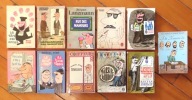
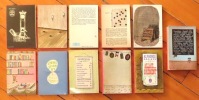
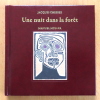

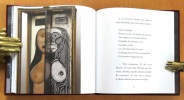


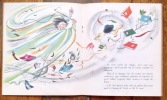
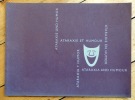
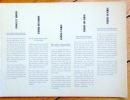
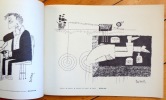

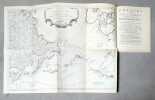
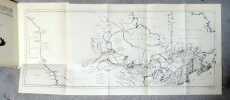
![Jim Morrison au-delà des Doors. . [Morrison Jim] Hervé Muller:](https://static.livre-rare-book.com/pictures/TBW/20034_1_thumb.jpg)
![Jim Morrison au-delà des Doors. . [Morrison Jim] Hervé Muller:](https://static.livre-rare-book.com/pictures/TBW/20034_2_thumb.jpg)
![Jim Morrison au-delà des Doors. . [Morrison Jim] Hervé Muller:](https://static.livre-rare-book.com/pictures/TBW/20034_3_thumb.jpg)
